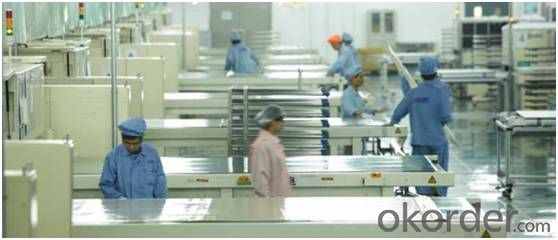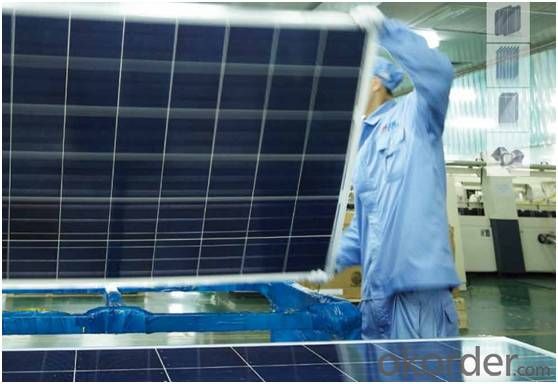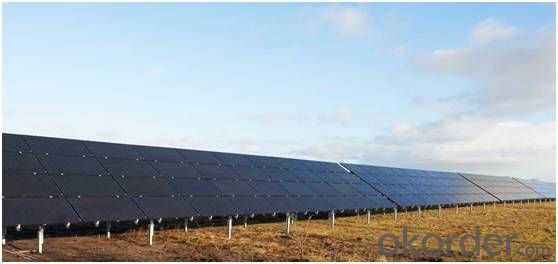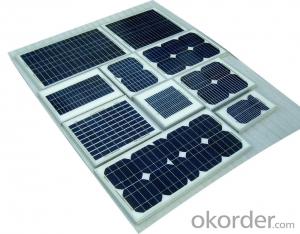Off-grid Solar Panel TDB125×125×2/3-36-P
- Loading Port:
- Ningbo
- Payment Terms:
- TT OR LC
- Min Order Qty:
- 100 carton
- Supply Capability:
- 10000 carton/month
OKorder Service Pledge
OKorder Financial Service
You Might Also Like

Specification:
· Highest performance enabled by higher efficiency monocrystal line cells and the latest Solar Wafer Technology for multicrystal line cells
· Lower weight design which reduces the total system load on a roof, making it ideal for residential customers. Its shape allows for better roof utilization
· Its low weight means easier handling for installers
· Modules are designed to withstand PID (Potential Induced Degradation)*
· High light transmission Anti-Reflective Glass with improved self-cleaning capability
· 0/+5 W Positive power tolerance for reliable power output
Warranty
CNBM Solar provides one of the most comprehensive module warranties in the industry:
· 10 years for product defects in materials and workmanship
· First 12 years for 90% of warranted minimum power
· Remaining 25 years for 80% of warranted minimum power
Certification
CNBM Solar strictly carries out the ISO 9001 quality control methodology and has implemented check points at every step of the production process to ensure our product performance durability and safety. The stringent quality control process has been confirmed by numerous independent agencies and LDK Solar modules earned IEC, TUV and UL certifications.
· IEC:IEC 61215, IEC 61730 (1&2), conformity to CE
· UL 1703 2002/03/15 Ed:3 Rev:2004/06/30
· ULC/ORD-C1703-01 Second Edition 2001/01/01
· UL and Canadian Standard for Safety Flat-Plate
· ISO 9001: 2008 Quality Management Systems
· CEC Listed: Modules are eligible for California Rebates
· PV Cycle: Voluntary module take back and recycling program
· MCS Certificate



FAQ
1. How do I decide which system is right for me ?
For protection from long outages, include a generator or solar panels in your Must solar system. Shorter outages can be handled by a battery-only system.
2. Where my system will be installed ?
Must solar systems are usually wall-mounted near a home's main electrical (circuit breaker) panel.
3. How do I install my system ?
A must solar backup inverter is connected to a home electric system , we will supply detailed installation manual and videos for our customers .
How fast will my system respond to a power outage ?
Must solar inverters typically transfer to battery power in less than 16 milliseconds (less than 1/50th of a second).
What kind of batteries do the systems include ?
Must solar backup electric systems use special high-quality electric storage batteries.
- Q:i need how a solar panel works, if possible make as easy to understand as possible like because of this , this happens and if you could please put a web source you got it from
- Sunlight (photons) hit a piece of silicon and knock electrons out of it. That causes a flow of electrons, which is electrical current. simple enough? a better explanation from wikipedia: A solar cell is a device that converts the energy of sunlight directly into electricity by the photovoltaic effect. Sometimes the term solar cell is reserved for devices intended specifically to capture energy from sunlight such as solar panels and solar cells, while the term photovoltaic cell is used when the light source is unspecified.
- Q:Is there a free site or resource that will teach you how to do this? Hopefully step by step and tells you how to buy all the parts ect?Which is the best resource for sale earth4energy, homemadeenergy, ect? Do they actually work and also as well as those which are professionally done?They say it will cost under $200 for a panel, but how much will this panel actually produce I mean how many panels would you have to make to produce 00% of your homes energy?
- there are plenty of free sites that tell you how to install your own solar panels. Just google diy solar panels. as to how many panels you need, it depends on what all you're trying to have them run.
- Q:Can solar panels be installed on remote or off-grid locations?
- Yes, solar panels can be installed on remote or off-grid locations. In fact, they are particularly suitable for such locations as they do not require a connection to the traditional power grid. Solar panels can generate electricity by harnessing sunlight, making them a reliable and sustainable energy source for remote areas.
- Q:I know there's different brands of solar panels and they cost different amounts.But if anyone know the average price of one solar panel could you help me out?Also could you please list the size of the solar panel.
- Solar panels come in all sizes, from one that is in your calculator to 0 or 20 feet on a side. link has several examples with size and power. if you want more, search google for buy solar panel 00w or 200w or 50w to get a list with prices. .
- Q:Can solar panels be installed on factories or industrial buildings?
- Yes, solar panels can be installed on factories or industrial buildings. In fact, it is quite common for large-scale solar installations to be implemented on such structures, as they often have expansive rooftops or open spaces suitable for maximizing solar energy generation. Installing solar panels on factories or industrial buildings can help offset power consumption, reduce carbon emissions, and provide a sustainable source of energy for these facilities.
- Q:is this fact true? - its a limitation to solar panels during summer when it's in extremly hot countrie. I've heard it from my science teacher .. please give detail if you have any and any more benefits/limitations is welcomed .. Thank you :) !
- So what do higher temperatures do to solar photovoltaic panels? As temperatures rise, the efficiency of solar panels decreases. Heat causes electrical resistance to the flow of electrons. On days where the temperature is more than 75 degrees, the electrical resistance makes the voltage fall thereby producing less kilowatts per hour. Your roof is much hotter than temperatures on the ground. That’s why solar panels are not mounted flat to a roof. There’s usually a few inches of spaces between the panels and roof so air flow can easily pass through and cool the panels down. There are some photovoltaic panels that are designed specifically to operate in hotter temperatures. These panels have a higher temperature coefficient. This is especially important in high heat climates like Arizona or New Mexico, but probably wouldn’t make too much of a difference in New England (except maybe this year). If you do live in one of these areas, you should speak to your solar installer to make sure they are using they right equipment for your region. Please note: Solar thermal panels used to heat water can withstand high temperatures without any degradation. In fact, hotter temperatures would actually be better for these types of modules.
- Q:If I wanted to put some solar panels on my roof, how many would i need and how many watts would they have to be to be able to power my whole house?
- Actually even if you cover your whole roof with panels, you wont get enugh power to even run a tv, fan and light at the same time. Solar panels give out a very less power output.
- Q:Dont/Cant work alone?when you buya asolar panel you mUST GET bATTERIES, voltage regulators and many else stuff?cant they just work directly? or can i use normal batteres like Car batteries?The one who Really knows 0 pts. thanks
- It is a system, you can get a small scale panel that can do things like charge cel phones and ipods. The type of system I have installed on my home needs a converter that turns the dc current that is produced by the panels into ac current to run in my home. I don't have a battery system because I'm not off the grid. When I'm generating more electricity than I am using I sell it back to my utility and at night when I'm not gernerating any electricity I buy it back again. Basically my meter runs backwards durning the day and frontwards during the night.
- Q:I don't know anything about solar and what connections that have to be made. any advice and wisdom would be appreciated. thanks
- Yes. Basically, here's what you need (I'm keeping this general on purpose): The panels themselves -- how large an area depends on average power consumption and how much power you can get on average. That, in turn , depends on climate. You'd need more in Seattle than Tuscon, for example. I'd guess something in the neighborhod of 0 square feet. Depends also on haow many gadgets (printers, etc.) you have. You'll need a power storage system. Lithium gives you the best poser density (of off-the-shelf stuff) but an ordinary car battery works well and is reliable. And, of course, a control system to manage the power generation/storage/use so everything works together without that annoying smell that tells you you just cooked a few hundred bucks worth of equuipment! :)
- Q:How much electricity does a solar panel produce?
- The amount of electricity a solar panel produces depends on various factors such as its size, efficiency, location, and weather conditions. On average, a standard-sized solar panel can generate around 250 to 400 watts of electricity per hour under optimal conditions. However, this output can vary significantly throughout the day and across different seasons.
1. Manufacturer Overview |
|
|---|---|
| Location | |
| Year Established | |
| Annual Output Value | |
| Main Markets | |
| Company Certifications | |
2. Manufacturer Certificates |
|
|---|---|
| a) Certification Name | |
| Range | |
| Reference | |
| Validity Period | |
3. Manufacturer Capability |
|
|---|---|
| a)Trade Capacity | |
| Nearest Port | |
| Export Percentage | |
| No.of Employees in Trade Department | |
| Language Spoken: | |
| b)Factory Information | |
| Factory Size: | |
| No. of Production Lines | |
| Contract Manufacturing | |
| Product Price Range | |
Send your message to us
Off-grid Solar Panel TDB125×125×2/3-36-P
- Loading Port:
- Ningbo
- Payment Terms:
- TT OR LC
- Min Order Qty:
- 100 carton
- Supply Capability:
- 10000 carton/month
OKorder Service Pledge
OKorder Financial Service
Similar products
New products
Hot products
Hot Searches
Related keywords































